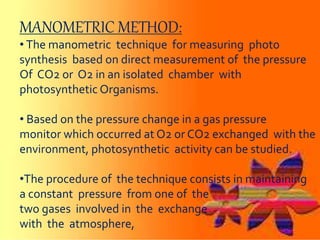Presentation1p2
- 4. ÔÇ° The complex process by which carbon dioxide, water, and certain inorganic salts are converted into carbohydrate by green plants,algae and certain bacteria, usin g energy from the sun and chlorophyll.
- 6. Methods of measuring the rate of photosynthesis There are few methods to measure the rate of photo Synthesis:  Measuring the increase in dry mass  Measuring the gas exchange  Manometric method  Fluorescence method
- 8. DRY MATTER ACCUMULATION METHOD: ÔÇßThis procedure involves cutting the entire plant or only the portion that is going to be measured. ÔÇßSubsequently, the sample is placed in a drying oven at a controlled temperature to avoid damage to the carbon content in the sample. ÔÇßThis process effectively removes any water from the tissue of the specimen to be analyzed. ÔÇßOnce the sample has been dried, it is weighed
- 9. to determine the amount of dry material accumulated. ÔÇßConsidering that photosynthesis produces the bulk of dry matter, this method of dry weight measurement is used to estimate the cumulative photosynthetic activity throughout the life of the plant.
- 10. MANOMETRIC METHOD: • The manometric technique for measuring photo synthesis based on direct measurement of the pressure Of CO2 or O2 in an isolated chamber with photosynthetic Organisms. • Based on the pressure change in a gas pressure monitor which occurred at O2 or CO2 exchanged with the environment, photosynthetic activity can be studied. •The procedure of the technique consists in maintaining a constant pressure from one of the two gases involved in the exchange with the atmosphere,
- 11. either pressure of O2 (pO2) or pressure of CO2 (pCO2), through the use of some chemical buffer. •The use of this technique for photosynthesis research has some disadvantages in terms of accuracy. •This is due to its sensitivity to environmental disturbances such as temperature, composition of the air and abiotic changes in the pressure of the vessel, Which requires maintaining very stable temperature and
- 12. environmental conditions of the vessel, in addition to the very slow changes in pressure and liquid to gas phase change. •Therefore, it is not a useful technique for monitoring rapid changing photosynthetic phenomena.
- 14. •The gas exchange method is currently the most commonly utilized technique for photosynthesis measurement at present for commercial equipment and experimental setups in order to measure individual leaves, whole plants, plant canopy and even forests. •This procedure consists of isolating the specimen or sample under test in a closed chamber to measure the gas concentration at the point when the chamber is closed. •After a few minutes the chamber has been closed, recording changes in the GAS EXCHANGE METHODS:
- 15. where the sample is completely enclosed to measure the difference in gas without contact with outside air. ÔÇß Open chambers: Where air can freely enter and leave the chamber flowing through the sample. proportions of gases from the air inside the chamber produced by the plant is also carried out. Consequently the O2 or CO2 exchange can be measured. ÔÉòThere are two types of gas exchange: ÔÇß Closed chambers:
- 16. Gas exchanger
- 17. I. CO2 exchange method: •In terms of photosynthesis measurement, the CO2 exchange is the most commonly used for building commercial and experimental photosynthesis monitoring systems. • In this technique, closed systems are used with IRGA (infra red gas analyzer) CO2 sensors to measure the initial concentration in an isolation chamber where the sample is placed under test to measure the final concentration after a period of time to allow for the photosynthesis of the plant.
- 18. •The open-flow systems have great advantages in comparison with closed systems because they do not require waiting for photosynthesis to occur in order to record the final concentration of CO2. Instead, they permit photosynthesis sampling on higher frequencies than closed systems. •Therefore, they are more useful for fast monitoring of photosynthetic phenomena. •This technique has been used for measuring photosynthesis in biological units in isolated chloroplasts using solid supports with the aim of observing CO2 fixation and O2 evolution.
- 19. Open chamber for co2 exchange
- 20. II. O2 exchange method: •This method provides an alternative to the CO2 exchange, which can be used as an additional tool combined with CO2 exchange in order to observe these phenomena. •The procedure utilized in this method is basically the same as using CO2.  This method has serious disadvantages: The O2 exchange technique is the difference between the initial and final, concentrations, this is, it is smaller compared to CO2 exchange systems and by this reason
- 21. the O2 exchange systems require high precision sensors and expensive data acquisition devices.  Another disadvantage is that the oxygen gas is more unstable than CO2 and has to be maintained at a high and very stable temperature (around 700°C) to maintain a stable molar concentration. Most recent research recommend a combination of an exchange of CO2 and O2 in order to obtain a more precise estimate of photosynthetic rate than using a single gas.
- 22. Fluorescence is the phenomenon whereby a certain amount of light energy is retained from illumination and subsequently released light after the light exposure time ceases to illuminate the sample fluorescence is used in various forms and has varied applications. Fluorescence method Chlorophyll imaging Chlorophyll Bacterial Oxygen
- 24. ÔÇ° Luminescent bacteria in the presence of photosynthetic O2 are used as a biosensor technique. ÔÇ° The procedure is initiated by placing the bacteria in a chamber and combining it with a solution of microalgae. ÔÇ° Once this solution is combined, light conditions are applied to start photosynthesis in the algae of the solution. ÔÇ° Later, the developed instrument turns mechanically the bacteria container in which the sample is placed in a measurement mode in order to quantify the bacteria fluorescence.
- 25. ÔÇ° In this way, the amount of fluorescence of the bacteria is proportional to the amount of O2 dissolved in the solution under test. ÔÇ° Consequently, the concentration of O2 in water depends on the photosynthetic activity carried out by microalgae. ÔÇ° This technique has been applied for rapid detection of herbicides that inhibit the activity of photosynthetic cultivation in microalgae.
- 26. ÔÇ° This is a variant of the estimation methods of photosynthesis by fluorescence that has been widely used recently. ÔÇ° This technique is to harnesses the fluorescence that is produced when the chlorophyll is illuminated and then releases the stored energy as red fluorescence. ÔÇ° some methods of chlorophyll fluorescence in canopy have been developed. IA method capable of measuring photosynthesis by the spectral reflectance measured from the surface of plants and comparing results with an IRGA has also been reported.
- 27. ÔÇ° This technique is an extremely useful tool, capable of being used in studies of various types of environmental stress in plants because it is a simple technique to understand low cost and possesses great versatility in several applications.
- 28. ÔÇ° The technique of O2 fluorescence is a variant which requires the application of cyan dye reactive to oxygen to measure the concentration of intracellular oxygen through a fluorometer applied to plants injected with the dye. ÔÇ° Due to the application of an optical multifrequency phase modulation technique, chlorophyll from O2 fluorescence can be discriminated.
- 29. ÔÇ° This methodology is based on the same principle used by chlorophyll fluorescence measurement. ÔÇ° It differs from the chlorophyll fluorescence measurements as these are made by measuring fluorescence in a timely manner and it is not possible to fully understand the different photosynthetic areas in the same leaf. ÔÇ° This technique uses a camera as a photo detector, with the significant advantage of providing a complete picture of the fluorescence of the sample making it possible to observe.
- 31. ÔÇ° This technique is useful to obtain a complete graphically measurements of the sample and that contains much more information than a spot metering. ÔÇ° The disadvantage here is that the cost of traditional fluorometers has increased.































